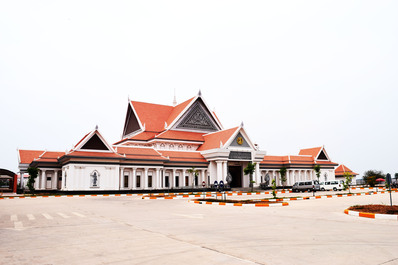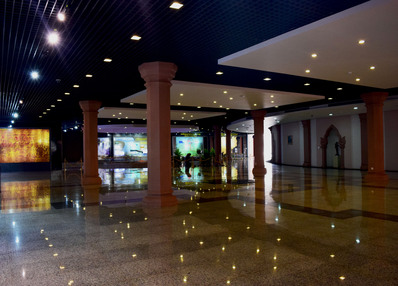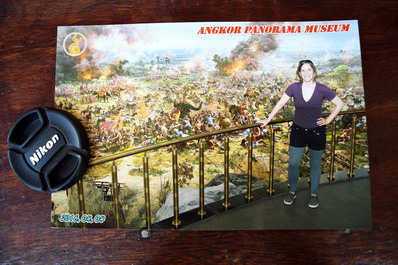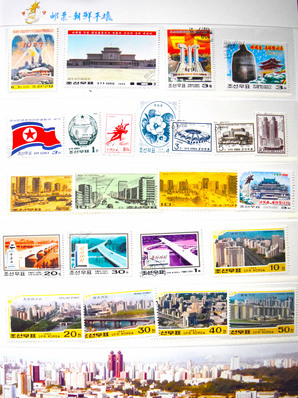Take one look at my bookshelf, and you're guaranteed to see floor-to-ceiling titles about North Korea. I've worked with refugees from the DPRK for six years now and lived in South Korea for three. At this point, no longer phased by the Kim regime's dangerous, yet painfully awkward (and even unintentionally funny) antics. After all, this is the same government that uses cartoons to depict Americans as badass, high-tech wolves, and their own people as doe-eyed chipmunks.
Talk about being culturally tone-deaf.
But when North Korea built a museum about Cambodian history in Siem Reap - one that took millions of dollars to build - I knew I had to go. Living in Cambodia myself, I figured the tuk tuk ride was well worth $7.
While I wasn't expecting the museum to provide a an accurate history lesson, it seemed like a valuable insight into the Hermit Kingdom's latest attempt at earning hard currency. Maybe I could even find some North Korean snacks to buy my defector friends, who, despite the troubles they suffered, tend to miss their homeland foods very much.
When you first enter the palatial museum, it's unclear where to walk first. In front of you is a floor-to-ceiling mural of an ancient Khmer statue. To your left is a visitor's counter, and to your right, a huge room with marble floors and exhibits. Veering on the side of caution, I chose to approach the counter first.
Two Khmer attendants outfitted in pink Tommy Hilfiger shirts explained to me that the first part of the museum was free. Viewing the panorama painting and historical film, however, cost $15. I decided to buy a ticket. (Who is to say if I'll would be able to see the film after this article goes live?)
As you walk in, a sign warns you that smoking, littering, and photography are banned in the exhibit. I did manage to sneak in this photo of the first room:
While it looks huge, the information is minimal and the analysis superficial. You'd be much better off visiting the temples with a local tour guide. The museum contains only images of the most famous Angkor temples, and a plaque listing their names, the king who authorized it, the style, period, and religion that guided its aesthetic. Unfortunately, whoever took these photographs did not wait until the low tide of tourist traffic. Cambodia's immense natural beauty is offset by Western tourists in bikinis and sun hats.
Silently, I couldn't help but wonder if these people know they're featured half-naked in a Cambodian museum.
Touch-screen computers offer more information about the temples, either in Khmer, English, or "Joseon-eo." (If you speak Korean, you'll notice they use the Northern term rather than the Southern one.) Here, you can find a wealth of information about each of the monuments and their historical significance, although the text is dry and dense.
At the end of the first room, visitors have the option of buying a $15 ticket and being escorted to the Angkor Panorama. It took sixty-three North Korean artists one year and four months to complete the epic painting, which runs 13 meters high and approximately 122 meters long. Outsiders must concede, this artwork is deadly serious in its magnificence.
War horses' muscular bodies are outlined by the noontime sun, dust wreathes around their hooves, and a raging elephant raises its trunk in defiance as its rider hurls a spear at enemies. The painting is so incredibly detailed, it's hard to see where the diorama floor ends and the painted wall begins. Your tour guide will explain that the piece displays Khmer history from the late 12th to early 13th century, and while photos are not allowed, a silent man with a camera will take a touristy photo for about thirty cents. I decided to go for it.
When you've circumnavigated the panorama, your tour guide will discreetly switch off all the lights. (Remember, you're likely to be the only visitor in the dead-silent museum.) The attraction only opened in December of 2015, and it hasn't had enough time to establish itself in the tourism circuit. My guide did inform me, however, that local schools arrange field trips to learn about Cambodian history there. A kindergarten had stopped by a few hours before my visit.
If you've opted for the movie, you'll then be escorted to a large, modern theater that is similarly empty. As the staff fumbled with the projector, a North Korean male poked his head out from stage right. We made eye contact briefly before he retreated back into the dark curtains.
It was a minute or two of awkward silence before the film began. The first graphic had an oversaturated photo of Angkor Wat and the words: "ANGKOR PANORAMA MUSEUM 2015." Keep in mind, I visited one-third of the way into 2016.
I was starting to read the subtitles about the religious significance of Phnom Kulen's streams when I suddenly heard The Lion King.
Yes. Hans Zimmer's score from The Lion King, specifically, "This Land," which you can hear when Mufasa's ghost appears to Simba in the clouds.
There's that "unintentionally funny" thing again.
In that moment, I was reminded of the strange manner in which North Korea is integrated into the global economy. It's taking small steps to move out into the world, moving into "least developed countries" like Cambodia and attempting to provide some of the high technology that is hard to find domestically.
Granted, I can't blame North Korea too much for this Disney-themed misstep. They probably helped animate make that blockbuster from 1994. If you ever visit the Joint-Security Area along the DMZ, which separates the two Koreas, the United Nations staff will play a similarly weird movie clip featuring the Pirates of the Caribbean score. I had to suppress a snicker then, too.
The film is approximately 8 minutes long and full of jerky CGI characters building Angkor Wat. In true North Korean fashion, lens flare is abundant, and the script is extremely melodramatic. More than an informational film, it's a celebration of the workers who labored to build one of humanity's greatest architectural achievements. There is perhaps a bit of socialist realism to be gleaned in the approach.
The approach is intriguing, but not really all that effective at engaging people who are actually just a few kilometers from Angkor Wat..
At the end, the lights switch on, and you'll find yourself back in the deserted theater.
You can stroll into a gift shop, which features a modest café and saleswomen in more pink polo shirts. As I looked over plaques naming North Korean artists, one shopkeeper let out a quiet "Annyeonghaseyo."
I turned to her, smiled, and used my shoddy Korean language skills to tell her that I lived in Seoul. Surprisingly, she wasn't at all phased to have a Caucasian speaking Korean, unlike the situation in South Korea. She was even kind enough to humor me by answering my questions in my third language, even when I probably spoke like a drunk third-grader.
Together, we looked over books of postage stamps made in North Korea. If my host knew my colleagues and I routinely work to collapse the regime, I don't think her courtesy still would have wavered. Everyday North Koreans are far more aware of the outside world than most laypeople would anticipate. We had a genuinely pleasant conversation.
"There's the Arirang Games," I said, pointing at one stamp.
The shopkeeper nodded.
"And there's the Chollima," I said, pointing to the legendary Pegasus statue from Pyongyang. That did surprise her. "Oh, you know that?" she said.
I took that as my cue to shut up. I paid $40 for the stamp book and left.
While it is hotly controversial to engage in business with North Korean enterprises, I firmly believe that places like the Angkor Panorama Museum give North Koreans first-hand, friendly experiences of the outside world. These first-hand accounts are likely to permeate the Pyongyang upper and middle classes, and ultimately, lead to real change. If we see how economic sanctions have backfired and note how options have narrowed, one can't help coming to the conclusion of Dr. Andrei Lankov, who writes: "...outside pressure is ineffective, [and] change will have to come from the North Koreans themselves. The United States and its allies can best help them by exposing them to the very attractive alternatives to their current way of life."
$40 stamp books and $15 entrance fees certainly aren't going to keep a nuclear program afloat. Without a doubt, drug trafficking is far more profitable than building museums. But when workers tell their families about a friendly, Korean-speaking American who knows the Chollima mythology, suddenly the foreign media contained on smuggled USBs seems more credible. Perhaps then, the seeds of dissent are planted.
Due to the attraction's small size and lack of substantial information, I doubt it will ever become a hot tourist spot. But these small amounts do create spaces where North Koreans can interact with people from so-called "enemy countries." This is one of the only places in the world where Pyongyang residents can interact with people outside their race and culture, which is especially important after the recent closing of Kaesong Industrial Complex.
After all, peace doesn't start with trumpets and confetti. More often, it starts quietly, with a gentle hello, a peek from behind the curtain, or even two women admiring a book of stamps.






